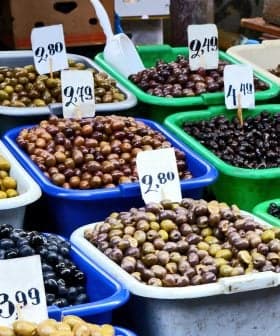Report: Only One-Third of Italian Olive Oil Producers Are Competitive

Italy’s olive oil production faces challenges due to a decline in production and a higher demand than supply, resulting in the need for imports to satisfy internal demand. The sector’s negative trade balance is attributed to the disparity among producers, with a majority considered “marginal,” prompting the need for innovation and collaboration to increase competitiveness and value in the market.
A new report from the Institute of Services for the Agricultural and Food Market (Ismea) has laid bare Italy’s growing olive oil trade challenges.
In the past several crop years, Italian olive oil production has experienced a downward trend. Meanwhile, olive oil consumption continues to far outweigh production, which means imports are required to satisfy internal demand.
Tradition has become a value to defend at all costs and has marginalized the best farming practices and science, which could instead help to cost-efficiently uplift production volumes and the farmers’ income.
As a result, olive oil imports are considerably higher than exports, and the sector has consistently endured a negative trade balance, with 2020 serving as a rare exception.
According to Ismea, national production, on average, reached 288,000 tons in the last four crop years, about one-third of all the olive oil produced, traded and marketed by Italian companies.
See Also:Italy Overtook Spain as Largest Olive Oil Supplier to U.S., Data ShowsIn the same period, olive oil imports amounted to an average of 566,000 tons, with 478,000 tons destined for local consumption. Separately, 344,000 tons of olive oil are destined for export, with the remainder going to industrial activities.
The immense disparity among the different types and sizes of olive oil producers in Italy is part of the reason for the current market situation, according to Ismea.
The sector is comprised of more than 600,000 companies, only 11 percent of which are considered “highly competitive.” Twenty-six percent of those agribusinesses are considered “potentially competitive” due to their specialization in olive growing or their ability to reach the markets which provide space for growth.
The remaining 63 percent of all olive oil-producing companies are considered “marginal.” These are medium businesses that are not specialized in olive oil and do not do what is necessary to reach the market and expand their activities.
Another portion of the “marginal” producers are small businesses focused on olive growing part-time or family-run small farms that reach the market but do not produce relevant volumes.
Small producers whose activity is focused on self-consumption or direct sales to small local customers are also accounted for among the “marginal” producers. Of all sales to families, which account for 70 percent of Italian olive oil sales, 26 percent go to self-consumption or direct sales.
The Italian Association of the Oil Industry (Assitol) confirmed that the relations within the production chain and the lack of efficient integration are the sector’s weakest points.
“If both new and traditional competitors prosper today, that happens because they know how to act as a whole, deploying innovation and, more recently, giving value to sustainability,” Anna Cane, Assitol’s olive oil group president, told Olive Oil Times.
She added that those are the reasons why the Inter-professional Olive Oil Organization (FOOI) was recently founded. The organization focuses on helping all types of olive oil producers increase their competitiveness in the market.
“The road is still very long, but we did already manage in a few cases to experiment with new agreements which are bringing good results,” Cane said.
According to Ismea, the segmentation of the Italian sector becomes evident just by looking at the oil mill numbers.
“In Spain, where olive oil production greatly exceeds one million tons, there are between 1,600 and 1,700 oil mills,” Ismea said. “In Italy, there are 4,470 oil mills… only 20 percent of which are cooperative oil mills.”
Still, Ismea said the proximity of the oil mills to the production areas is of such relevance that even the high costs might be justified.
“Seventy-six percent of Italian oil mills operate with less than 500 tons of olives,” Ismea said. “Even if their high number inflates the cost of the overall sector, their availability in the vicinities of the production areas allows olive transformation within 24 hours from harvest, an essential quality factor.”
Among the most competitive Italian olive oil companies are the small agribusinesses that are highly specialized and strongly focused on the quality of their product. These companies often depend on their own mill or work with nearby specialized companies.
“The Covid-19 pandemic has brought producers and consumers closer to each other, as consumers increasingly look for true olive oil artisans,” Antonella Rosati, the owner of Tenuta Foggiali in Puglia, told Olive Oil Times.
“It is a trend that should be valued, that should not stop, and I see signs that it is taking off thanks to many young olive farmers focusing on high-quality production,” she added.
Tradition and high-quality products coupled with the latest technology are the focus of many medium and small producers who look at the international markets where they show they can compete.
Still, the Ismea report emphasized how extra virgin olive oils certified with Protected Designation of Origin (PDO) and Protected Geographical Indication (PGI) status represent only a handful of the total olive oil production, “far beyond the potential of the sector.”
PDO and PGI oils account for no more than three percent of production volumes and reach six percent of market value.
However, Cane added that there is a delicate balance that producers must strike between following traditional production methods and innovating to remain competitive.
“If the sector does not innovate we will not be able to fill the production gap,” Cane said. “But in Italy, tradition has become a value to defend at all costs and has marginalized the best farming practices and science, which could instead help to cost-efficiently uplift production volumes and the farmers’ income.”
While top quality producers find their clients among those accustomed to or interested in more expensive products, many in the olive oil industry believe that good olive oil also needs to be brought to the market with the right message.
“Stating that good olive oil must be costly risks making extra virgin olive oil consumers flock away from the product,” Cane said. “The adequate valorization of [olive oil farmers] is essential. However, avoiding most extra virgin olive oil being dumped as a promotion or underpriced product is too.”
Given its dependency on foreign production, olive oil prices are greatly affected by the imports in Italy. Still, the report showed that the selling price does not change significantly over time. This is a sign that oscillations in the import prices unevenly affect the product chain.
“The retail prices follow dynamics that are more affected by the product distribution chain than by the ups and downs of the production,” Ismea said.
Between 2016 and 2021, extra virgin olive retail prices have shown a slightly negative but substantially fixed trend, with prices oscillating between €5.50 per liter to the current €4.70.
In that same period, prices at origin have followed a substantially different curve, with prices reaching €4.30 in 2017 and dropping to €2.50 in 2020.
“The strong oscillations in the prices at origin are mostly absorbed by the industry and by the food retailers with the goal of offering a stable selling price to the consumer,” Ismea said.
Among the other weak points highlighted by Ismea for the sector are excess bureaucracy, limitations in access to irrigation, slow generational change at the highest ranks of producing companies, abandonment of unprofessionally managed olive orchards, limited access to credit and producers’ weak negotiating power with the food resellers.
However, Ismea added that there are opportunities in the growing demand for quality and sustainability from consumers. The report said that there are also opportunities to extend olive growing northward due to climate change.
Expanding olive oil tourism activities is another opportunity that Ismea identified for producers to diversify their farming activities and supplement their income.









